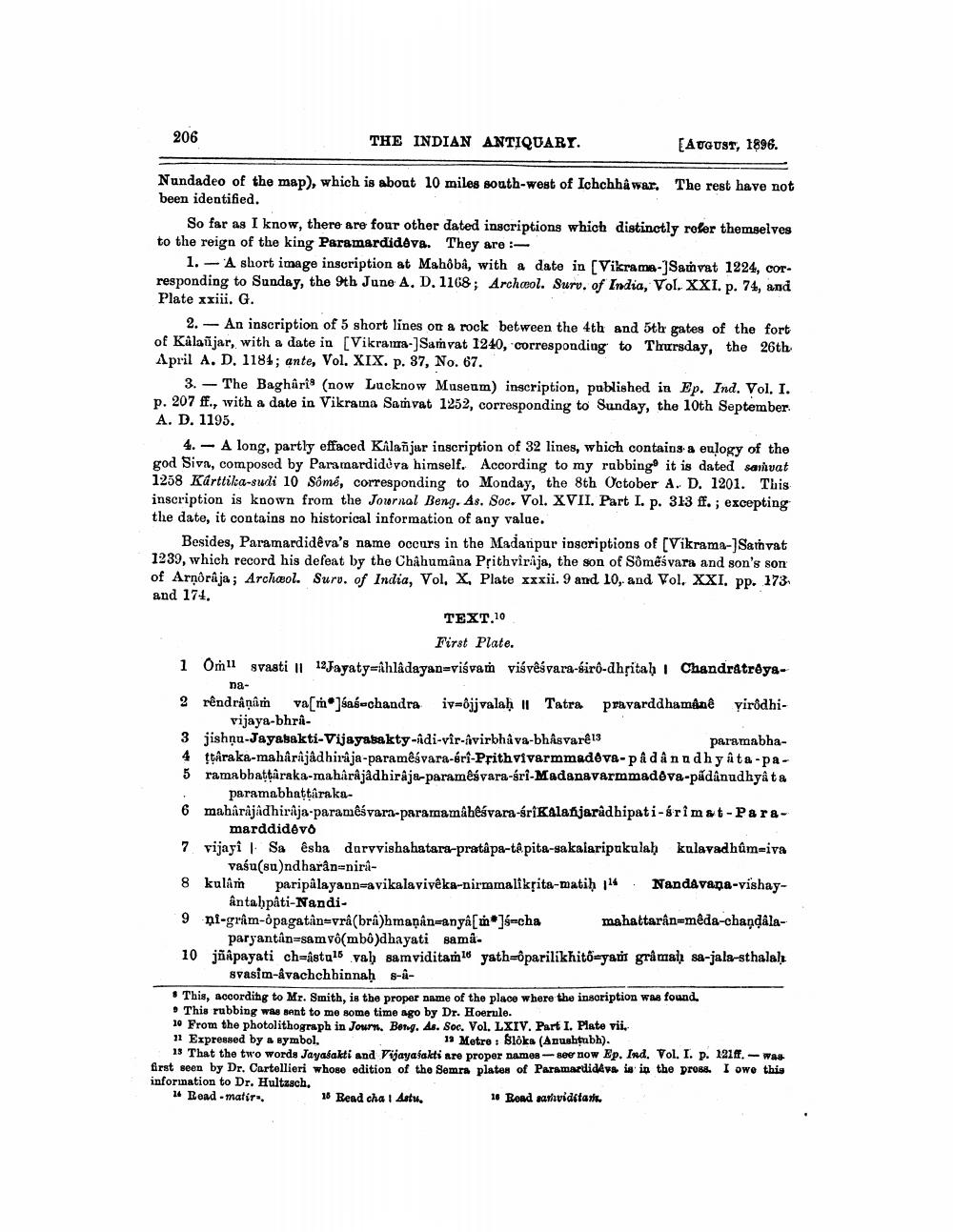________________
206
THE INDIAN ANTIQUARY.
[AUGUST, 1896.
Nundadeo of the map), which is about 10 miles south-west of Ichchhâwar. The rest have not been identified.
So far as I know, there are four other dated inscriptions which distinctly refer themselves to the reign of the king Paramardidêva. They are:
1. A short image inscription at Mahoba, with a date in [Vikrama-]Samvat 1224, corresponding to Sunday, the 9th June A. D. 1168; Archaeol. Surv. of India, Vol. XXI. p. 74, and Plate xxiii. G.
2.
An inscription of 5 short lines on a rock between the 4th and 5th gates of the fort of Kalañjar, with a date in [Vikrama-]Samvat 1240, corresponding to Thursday, the 26th April A. D. 1184; ante, Vol. XIX. p. 37, No. 67.
3.The Baghâris (now Lucknow Museum) inscription, published in Ep. Ind. Vol. I. p. 207 ff., with a date in Vikrama Samvat 1252, corresponding to Sunday, the 10th September.
A. D. 1195.
4. A long, partly effaced Kilañjar inscription of 32 lines, which contains a eulogy of the god Siva, composed by Paramardidèva himself. According to my rubbing it is dated saivat 1258 Kartlika-sudi 10 Sômé, corresponding to Monday, the 8th October A. D. 1201. This inscription is known from the Journal Beng. As. Soc. Vol. XVII. Part I. p. 313 ff.; excepting the date, it contains no historical information of any value.
Besides, Paramardidêva's name occurs in the Madanpur inscriptions of [Vikrama-]Samvat 1239, which record his defeat by the Châhumana Prithviraja, the son of Sômésvara and son's son of Arnôrâja; Archaeol. Surv. of India, Vol, X, Plate xxxii. 9 and 10, and Vol. XXI. pp. 173. and 174.
TEXT.10 First Plate.
1 Om svasti 1 12Jayaty-ahlâdayan-viśvam viśvêsvara-sirô-dhritah
Chandratreya
na
2 rêndrânâm va[m]sas-chandra iv-ôjjvalah Tatra pravarddhamanê virôdhivijaya-bhrâ
3 jishnu-Jayasakti-Vijayasakty-idi-vir-âvirbhâva-bhâsvarê13
paramabha
4 ttaraka-mahârîjâdhiraja-paramêsvara-érî-Prithvivarmmadova-på dân ndhyâta-pa
5 ramabbaṭṭaraka-maharajâdhiraja-paramêsvara-sri-Madanavarmmadova-pădânudhyât a
6 maharajadhiraja-paramêsvara-paramamâhêśvara-śrîKalañjaràdhipati-śrimat-Para
marddidêvo
7 vijayî Sa êsha durvvishahatara-pratâpa-tê pita-sakalaripukulaḥ kulavadhûm=iva vasu(su)ndharân-nirâ
8 kulim
paripâlayann-avikalavivêka-nirmmalikṛita-matiḥ 114
Nandavana-vishay
mahattarân-mêda-chanḍâla
paramabhattaraka
intabpiti-Nandi
9 nl-grim-pagatin=vri(brå)hmapin-any[*]i-cha
paryantân-sam vô(mbô)dhayati sama
10 jäâpayati ch=âstu15 vah samviditam yath-ôparilikhito-yam grâmal sa-jala-sthalaḥ svasim-âvachchhinnaḥ s-a
This, according to Mr. Smith, is the proper name of the place where the inscription was found.
This rubbing was sent to me some time ago by Dr. Hoerule.
10 From the photolithograph in Journ. Beng. As. Soc. Vol. LXIV. Part I. Plate vii.
11 Expressed by a symbol.
13 Metre: Sloka (Anushṭubh).
13 That the two words Jayasakti and Vijayasakti are proper names-see now Ep. Ind. Vol. I. p. 121ff. - was first seen by Dr. Cartellieri whose edition of the Semra plates of Paramardidéva is in the press. I owe this information to Dr. Hultzsch.
14 Read-matir,
15 Read cha 1 Astu.
16 Read sarviditam.




